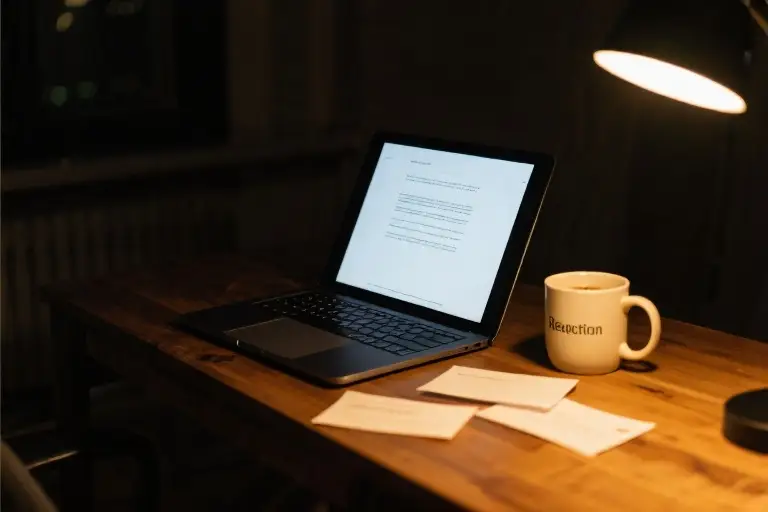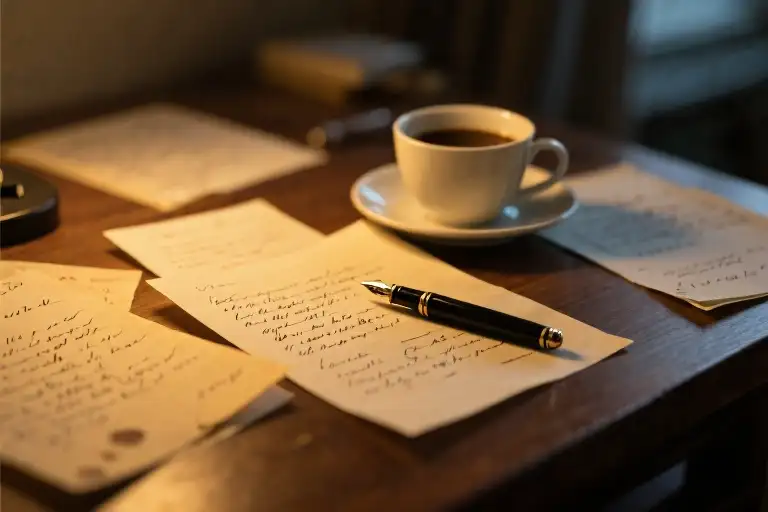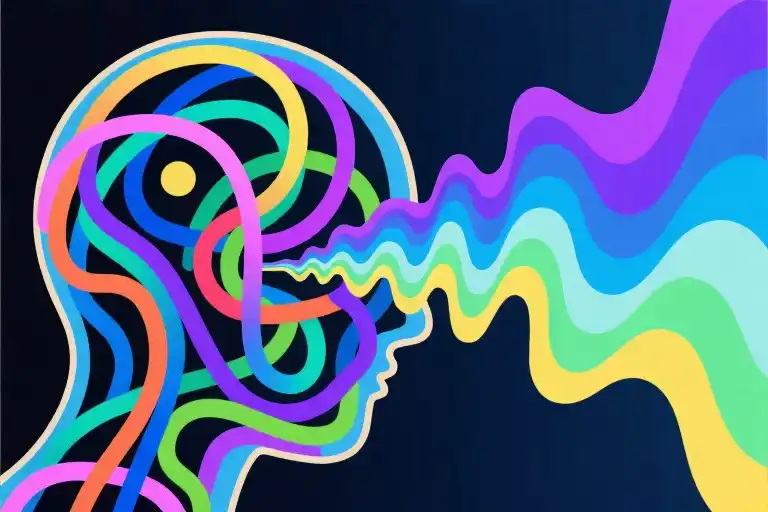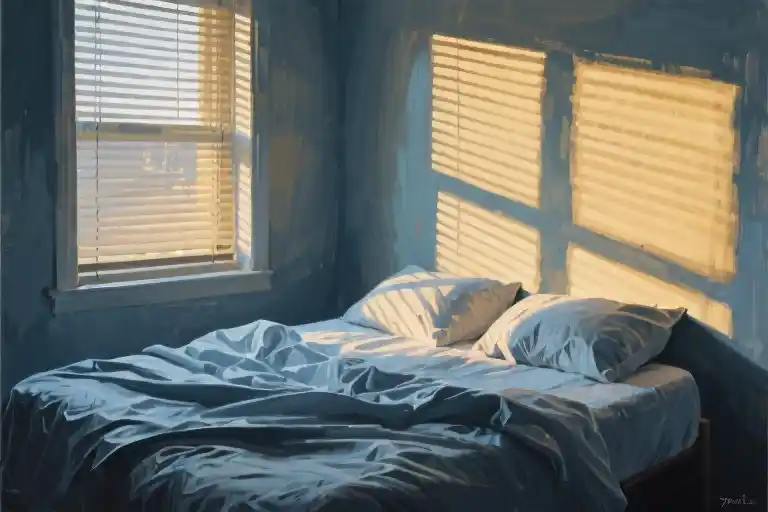The cursor blinks relentlessly at 3:17 AM, mocking the seventeenth rewrite of your opening paragraph. Your coffee has gone cold three times. Then the email notification pops up – another rejection letter, the eighth this month. The editor’s polite “not the right fit for our current needs” echoes like a verdict in the silent room.
We’ve all been there. That moment when the words won’t flow, when every sentence feels like wading through mental quicksand, when even your favorite pen seems to rebel against the page. Writer’s block isn’t just about lacking ideas – it’s the creeping doubt that maybe you’ve run dry, that perhaps you were never meant to do this at all.
What makes this particular creative block so paralyzing isn’t the blank page itself. It’s the way rejection amplifies our deepest insecurities. That US-based magazine’s polite dismissal didn’t just reject one story – in our vulnerable state, it feels like they rejected our voice, our perspective, our very right to create. The blinking cursor transforms from a neutral marker to an accusatory pulse: Who do you think you are?
Yet here’s what they don’t tell you in writing workshops: creative burnout recovery isn’t about waiting for inspiration to strike. It’s about understanding why we freeze. Neuroscience shows that writer’s block often occurs when our brain’s executive function (the part that critiques and edits) overwhelms our default mode network (the creative dreamer). Essentially, your inner editor has taken the microphone from your inner artist and won’t give it back.
So what now? When reading others’ work brings envy instead of inspiration? When walks just remind you of all the stories you’re not writing? I learned the hard way that overcoming writing motivation tips can’t be found in more caffeine or prettier notebooks. The solution lives in something much simpler yet profoundly difficult: giving yourself permission to write badly, to be rejected, to keep going anyway.
That rejection letter from January? I framed it. Not as punishment, but as proof that I showed up, that I risked failure. Because the writers who succeed aren’t those with magical talent – they’re simply the ones who outlasted their self-doubt. Your words matter. Even when they come slowly. Even when editors don’t see their value yet. Especially then.
How did you last survive a creative block? What small step can you take today to reconnect with why you started writing in the first place?
The Anatomy Lab of Creative Block
Every writer knows that moment when the words stop flowing. Your fingers hover over the keyboard while the cursor blinks with mocking regularity. The pristine document before you feels less like a blank canvas and more like an insurmountable wall. This isn’t just frustration – it’s your brain’s creative networks at war.
The Neuroscience Behind Your Blank Page
When creative block strikes, there’s an actual biological battle happening in your brain. Your prefrontal cortex (the organized, analytical manager) and your default mode network (the daydreaming innovator) are locked in a tug-of-war. Research from Stanford’s Creativity Lab shows that during writer’s block:
- The prefrontal cortex goes into overdrive with self-editing and criticism
- The default network (responsible for spontaneous ideas) gets suppressed by stress hormones
- Neural pathways that normally connect ideas develop temporary ‘roadblocks’
This explains why forcing yourself to write often backfires. As novelist John Steinbeck noted in his journal: “When I’m blocked, it’s because my inner critic arrived at work before my creative self.”
Three Faces of Perfectionism Paralysis
Creative block often wears the mask of perfectionism. Through working with hundreds of writers, I’ve identified three common patterns:
- The Endless Reviser
- Can’t move forward because you keep editing the same paragraph
- Root cause: Fear that the final product won’t match your vision
- Telltale sign: More than 5 saved drafts of the same document
- The Preparation Addict
- Constantly ‘researching’ but never writing
- Root cause: Anxiety about insufficient expertise
- Telltale sign: Bookmarks folder with 200+ ‘reference’ articles
- The First-Line Perfectionist
- Can’t start until the opening is ‘just right’
- Root cause: Overemphasis on hooking the reader immediately
- Telltale sign: 30+ abandoned documents titled “Great American Novel Attempt #__”
What Type of Creative Block Do You Have?
Take this quick diagnostic (circle your answers):
When stuck, do you:
A) Keep rewriting the same section until it’s ‘perfect’?
B) Feel you need to research more before continuing?
C) Struggle to write anything because nothing sounds good enough?
D) Feel completely empty of ideas?
Your results:
- Mostly A: Endless Reviser
- Mostly B: Preparation Addict
- Mostly C: First-Line Perfectionist
- Mostly D: True Creative Exhaustion (requires different solutions)
This distinction matters because each type needs a different recovery approach. The Preparation Addict needs permission to write ‘badly’, while the Endless Reviser needs structured breaks from editing.
Remember: Creative block isn’t failure – it’s your brain’s way of signaling that your current approach isn’t working. In our next section, we’ll build customized solutions based on your block type. For now, take comfort in knowing even Margaret Atwood experiences this. As she quipped: “Writer’s block is just your brain saying ‘I don’t want to do this stupid thing anymore.'”
Emergency Room for Inspiration: Tiered Rescue Strategies
Code Red: Immediate Relief Tactics
When writer’s block strikes like a lightning bolt, you need first-aid measures that work within minutes. Neuroscience shows that creative blocks often occur when our brain’s default mode network (responsible for daydreaming and imagination) fails to sync with the executive control network. Here’s how to reboot your creative circuits:
Sensory Shock Therapy
Keep an “inspiration emergency kit” containing:
- Peppermint essential oil (studies show mint scent increases alertness by 28%)
- An ice cube in a ziplock bag to press against your wrist
- Texture cards (sandpaper/silk/velvet) for tactile stimulation
Alternate between sniffing, touching, and listening to white noise for 90 seconds. This multisensory jolt disrupts neural fixation patterns, giving fresh perspectives.
5-Minute Wild Writing Protocol
Open a blank document and set a timer. Write continuously without:
- Deleting
- Rereading
- Lifting your fingers from the keyboard
Prompts to try:
- Describe your creative block as a physical object (Is it a rusty padlock? A overstuffed closet?)
- List 20 terrible ideas for your current project – the worse, the better
- Copy the last text message you sent and expand it into a 200-word scene
Code Yellow: Mid-Term Recovery Plans
When the initial panic subsides but motivation remains low, implement these systems:
Creative Energy Journal
Track for 7 days:
🕒 Peak productivity hours
☕ Caffeine/meal impacts
📊 Word count vs. perceived effort (rate 1-10)
🎵 Soundtrack that worked
Patterns will emerge – maybe your best metaphors come after yoga, or dialogue flows better when writing in comic sans font.
Controlled Venting Days
Schedule weekly “grieving hours” to:
- Rant about rejections in a voice memo
- Tear up printed drafts (safely!)
- Watch terrible movies to appreciate your own work
Set boundaries: Venting sessions end with a ritual (burning a bay leaf, flushing ice down the toilet) to symbolize release.
Code Green: Long-Term Resilience Building
Personal Creative Circadian Rhythm
Map your natural cycles over 30 days:
🌅 Morning (6-10am): Raw creation
☀️ Midday (10am-2pm): Research/editing
🌙 Night (8-10pm): Idea incubation
Protect these phases like religious ceremonies. Inform housemates, use physical indicators (special lamp/playlist), and track adherence.
Strategic Quitting List
Not all ideas deserve your time. Regularly audit:
❌ Genres that drain you (maybe historical fiction isn’t your forte)
❌ “Prestige projects” you pursue for external validation
❌ Expired ideas you’ve outgrown
Create a ceremonial “goodbye” for abandoned projects – one writer I know buries printed drafts in her garden as compost for new growth.
Pro Tip: Combine methods – try wild writing while sniffing peppermint oil during your peak creative hour. The layered stimulation often produces breakthrough ideas.*
The Alchemy of Rejection Letters
That crumpled email in your inbox with the polite yet soul-crushing “not the right fit” isn’t the end—it’s raw material waiting to be transformed. Every great writer’s career is built upon a foundation of rejection letters, each one containing hidden insights if you know how to read them.
Case Study: The Manuscript That Lived
When Bloomsbury finally accepted Harry Potter and the Philosopher’s Stone after twelve rejections, those earlier dismissal letters became legendary. One particularly memorable response advised J.K. Rowling to “get a day job” because “children’s books don’t make money.” What makes this rejection golden isn’t its irony in hindsight, but what it reveals about publishing blind spots:
- Industry assumptions about market viability often miss emerging trends
- Tone deafness to original voices that don’t fit established molds
- The subjective nature of “fit” (one editor’s trash is another’s bestseller)
The Rejection Decoder Matrix
Turn vague rejections into actionable insights with this four-quadrant analysis tool:
| Rejection Phrase | What It Might Mean | Experiments To Try |
|---|---|---|
| “Not the right fit” | Voice/style mismatch | Submit to 3 radically different publications |
| “Too quiet” | Pacing/conflict issues | Add deadline pressure to your next draft |
| “Seen this before” | Overused tropes | List 5 clichés in your piece and invert them |
| “Didn’t connect” | Emotional authenticity | Rewrite key scenes using personal memories |
Your Turn: Rejection Remix Challenge
- Dig up your most painful rejection (we’ve all got one)
- Highlight the most frustrating comment
- Rewrite it as:
- A compliment (“Your dialogue is too realistic” → “You capture authentic speech patterns”)
- A writing prompt (“The ending falls flat” → “Write 5 alternative endings where the villain wins”)
- A permission slip (“Too experimental” → “This is your sign to go full avant-garde”)
Pro Tip: Create a “Rejection Hall of Fame” wall—when framed as artifacts of your creative journey, they become badges of courage rather than wounds.
The Hidden Curriculum of No
Every “no” contains a secret lesson:
- Form rejections teach resilience
- Personalized notes reveal industry standards
- Contradictory feedback highlights subjective tastes
- Silence trains detachment
Share in the comments: Which rejection taught you the most unexpected lesson? Let’s celebrate our collective growth through every “not for us” that led us exactly where we needed to be.
The Writer’s Survival Kit: Your Free Resources & Final Pep Talk
Before we part ways, let me leave you with two gifts that have saved my writing career more times than I can count. Consider this your emergency toolkit for when the words won’t flow and rejection letters pile up.
Your Downloadable Writing First-Aid Kit
I’ve compiled all the practical tools we’ve discussed into one convenient package:
- The 5-Minute Writing Spark Template (DOCX/PDF)
- Pre-formatted prompts for when you need to jumpstart your creativity immediately
- Includes sensory triggers and word association exercises
- Rejection Letter Autopsy Worksheet
- A step-by-step guide to transform criticism into actionable improvements
- Sample analysis of famous authors’ rejection experiences
- Creative Energy Tracker
- Printable mood/idea journal pages
- Color-coded system to identify your peak writing times
- Permission Slips for Bad Writing Days
- 10 pre-written excuses to guilt-free skip writing (when you really need to)
- Because sometimes the most productive thing is not forcing it
Download the complete toolkit here (ZIP file, 12MB)
“Having these tools ready cut my creative recovery time in half.” – Jamie R., novelist
The Last Word: Tonight’s Permission Slip
Here’s the hard-won wisdom I wish someone had pinned to my laptop years ago:
“You’re allowed to write terrible words tomorrow, but tonight you’re required to be gloriously, unapologetically human.”
When the weight of unfinished drafts and harsh critiques feels crushing:
- Eat the extra slice of cake
- Watch that ridiculous reality show
- Laugh at your own melodrama (I keep a “Worst Rejection Reactions” list for this)
The page will still be there tomorrow. Your unique voice will still be yours. What makes you a writer isn’t daily perfection—it’s showing up again after the breaks that save your sanity.
Your Turn Now
Before you close this tab:
- Hit download on that toolkit (future you will thank you)
- Leave a comment sharing:
- Your favorite “writing survival ritual”
OR - The most absurd rejection you’ve ever received
- Do one completely non-writing-related thing today
See you on the other side of the blank page.





